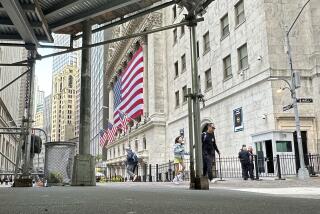Dollar Declines Steeply Against Japanese Yen : Advances on Other Currencies; Gold Dips
- Share via
NEW YORK — The dollar rose against most European currencies but fell sharply against the Japanese yen on world currency markets Thursday. Gold was off slightly.
Analysts suggested that Thursday’s trading provided evidence that the main goal of major industrial nations was to strengthen the yen more than push the dollar down against all currencies.
“At this point, no one really knows what was decided at the Big Five meeting” last Sunday, said Gary Dorsh, senior analyst at G. H. Miller & Co. in Chicago. “But an increasing number of traders are speculating that the primary effort is to raise the value of the yen against the dollar and other currencies.”
The reason, he said, is Japan’s huge trade surplus with the United States, which is the major irritant sparking protectionist efforts in Congress.
Concerted Action
On Sunday, the five major industrialized countries--the United States, West Germany, France, Britain and Japan--said that they would act in concert to try to deflate the U.S. currency.
Robert Ryan, senior trader at Irving Trust in New York, said he believes that “the great concern is with the yen,” since strengthening it would deflect pressure on the Reagan Administration for protectionist action.
Dealers in the Far East said the Japanese central bank stepped in to sell dollars several times during the trading day--whenever the dollar showed signs of recovery.
On Monday, the dollar plummeted 4.5%, but it held roughly steady on Tuesday and most of Wednesday. Late Wednesday, amid increasing dollar sales by the Japanese bank and the West German central bank, the U.S. currency began sliding and was further battered early Thursday in the Far East.
When trading finished in Tokyo, the dollar was at its lowest since March 7, 1984.
Question of Targets
Japanese press reports said the Bank of Japan was trying to lead the dollar down to the 200-210 yen level. A senior Bank of Japan official later denied that there was any specific target.
Banking sources said the West German central bank sold $55.8 million worth of dollars after the dollar was officially set at 2.6590 marks. That was the lowest since the fixing of 2.6491 on April 19, 1984.
Traders also said the Bank of France sold dollars to buy francs after the dollar was fixed in Paris at 8.1 francs, the lowest since 8.0655 francs on April 13, 1984.
But by the end of the day in New York, the dollar was up against all of the major European currencies except the Swiss franc.
Though it was reported that the Bank of Japan was intervening heavily, dealers said they were not sure how many other central banks were joining suit.
“Certainly at this point there would be no purpose to keep it a secret, because you can get more out of people’s knowing,” said Daniel Holland, assistant vice president at Discount Corp. of New York. “Look how far (down) we’ve gone with very little intervention.”
The dollar closed in Tokyo at 222.80 yen, down from 229.45 yen Wednesday. Later, in Europe, the dollar fell further, to 219.60 yen, or 9% down from its Tokyo close last Friday. In New York, it stood at 221.10 at the end of the day, off from 226.80 on Wednesday.
In London, the British pound was quoted at $1.4405 late Thursday, more expensive than the closing $1.42875 on Wednesday. Later, in New York, the pound slipped to $1.4195, cheaper than the $1.4455 of Wednesday.
Other late dollar rates in Europe, compared to late Wednesday, were: 2.6583 West German marks, down from 2.7145; 2.1775 Swiss francs, down from 2.2220; 8.125 French francs, down from 8.280; 3.0115 Dutch guilders, down from 3.0540; 1,800.00 Italian lire, down from 1,834.00, and 1.35835 Canadian dollars, down from 1.3615.
Other dollar rates in the United States, compared to Wednesday, were: 2.6823 West German marks, up from 2.6795; 2.1975 Swiss francs, down from 2.2035; 1.3615 Canadian dollars, up from 1.3584, and 8.1814 French francs, up from 8.1800.
Many currency dealers remained skeptical about the durability of the New York Big Five agreement.
“My friends think in the short run it is going to go lower, then come right back up just as fast,” Ryan said.
Dorsh said he did not think that the decline will hold “because the Reagan Administration has not addressed the root of the problem, which is the massive budget deficit, which keeps interest rates high and the dollar overvalued on foreign exchanges.”
“It’s only giving the patient some Novocain. It’s not treating the disease.”
Gold bullion was quoted at $327.70 an ounce at the New York Commodity Exchange, down $2 from Wednesday’s late price. At Republic National Bank in New York, gold was selling for $328.40, down from $329.50.
Gold closed in London at a bid price of $328.75 an ounce, compared to $328.50 late Wednesday.
In Zurich, the late bid price was $329.50, up from $329.00 late Wednesday.
Earlier in Hong Kong, gold rose the equivalent of $1.94 to close at $331.21 an ounce.
Silver was quoted in London at a bid price of $6.125 an ounce, down from $6.16 on Wednesday. At New York’s Comex, silver sold for $6.064, down 5.9 cents from Wednesday’s $6.153.
See foreign exchange tables, Page 11.
More to Read
Inside the business of entertainment
The Wide Shot brings you news, analysis and insights on everything from streaming wars to production — and what it all means for the future.
You may occasionally receive promotional content from the Los Angeles Times.










